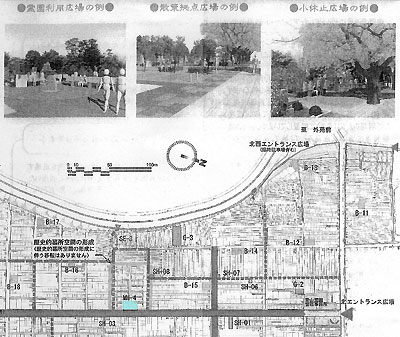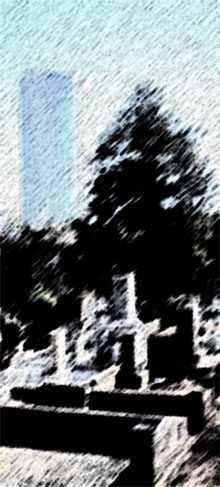Park Plans Unveiled

The plans incorporate parklets into the cemetery.
To follow up on the 2/21 fact finding mission, Sachiko, Stephen, and I went to the 23rd floor of Tocho to meet with Minowa-san and Hayashi-san in Kensetsu-Kyoku Koen-Ryokuchi-bu Reien-ka, Bureau of Construction of Parks, Green Areas and Cemeteries.
The upshot is the Foreign Section Trust is making headway toward persuading the authorities to treat the foreign section as an historical site in its entirety and establishing a constructive relationship on how this can be achieved.
They suggested that the relationship could take the form of a liaison between families and the cemetery management office, but more importantly, the door to providing a “safety net” for unclaimed graves could be opened via an NPO. Falling into that net are the graves not claimed by family, or deemed not important enough to save by the government, or the some forty graves listed as unknown by the city, half of which have been identified by us.
Their suggestions, of course, are subject to the vagaries of the city’s bureaucracy and plan to consolidate the section to make way for a park, but the formation of an NPO is clearly the path to achieve the FST’s aims.
At present, the plan for the park looks like this:
Aoyama Bochi park plan, South (2 MB PDF).
Aoyama Bochi park plan, North (2 MB PDF)
The North map (excerpted above) shows a park marked MH-4 next to the road, taking up about 7% of the foreign section with an accompanying artist’s conceptual drawing in the upper right hand corner. The purpose of the park is not clear. Nonetheless, we understand that the more space that can be made available through stone removals, the bigger the park will become.
In this regard, their brochure (to be uploaded soon) shows before and after pictures: overgrown greenery and charming stones replaced by wide paved areas with some trees neatly surrounded by a bit of grass and barriers.
More consideration on this subject is required, as an integral part of the foreign section’s value lies in the existing trees, greenery, paths, and stones. The establishment of the park could detract from the section’s current charm and beauty if the current circumstances were not incorporated wisely.
We were also worried about the destruction of stones and having unknowns or non-famous people combined into one grave. Some of our fears were assuaged when they stated specifically that part of the charm of the foreign section were the types of stones and markers that are used – many of them distinctly non-Japanese.
The city emphasized that their focus is on preserving the graves of important people and they are looking to the literature for references as their guide. We questioned if the city is the proper authority to be deciding who is important and who is not. Just because a name doesn’t appear in a listing of important people, doesn’t make a baby who died when they were two or the wife of a minister or teacher any less important in the telling of the story of that era.
When asked if embassies are allowed to pay for the graves, Mr. Minowa replied that embassies, churches, and schools related to the deceased have been approaching them, and they are considering changing the rules to accept payments. If an NPO was responsible for this and handled the foreign section as one large unit, instead of multiple smaller units, it may be easier for the city to manage.
As for reaching descendants outside of Japan and the inadequacy of the signs and the names in the register in katakana, the city says it is only following the letter of the law.
For future inquiries, the city said, an NPO could be entrusted with the government’s work of helping the families who can’t speak Japanese. We envision contacts in foreign embassies could expedite these inquiries.
If a family member from overseas is willing to pay the fees, they need to show proof of their kinship, have it translated into Japanese, and then send money. Recently, there was one family in Belgium who took steps to contact the city and followed through in the manner described.
Again, at this stage everything is unofficial, but they agreed that it would be impossible to track all the families down and understood that it is difficult to remove graves if the foreign section were to be made an historical site.
Even though the city maintains that it aims to preserve the section and the plan to move graves onto a plaque mentioned in the previous meeting did not come up, consolidating the section by asking paying plots to move to make way for the park will begin in earnest in the Summer. Further consolidation of unprotected plots would begin in October, the city says.
Posted by at March 15, 2005 12:39 AM



